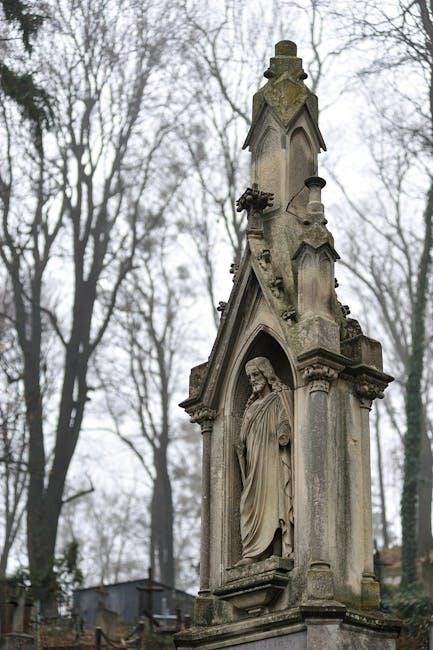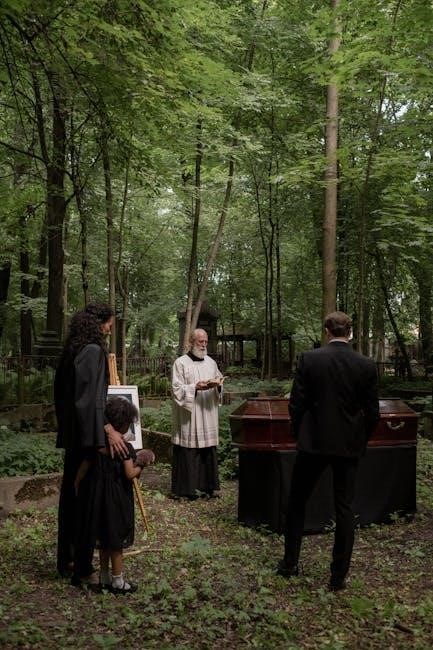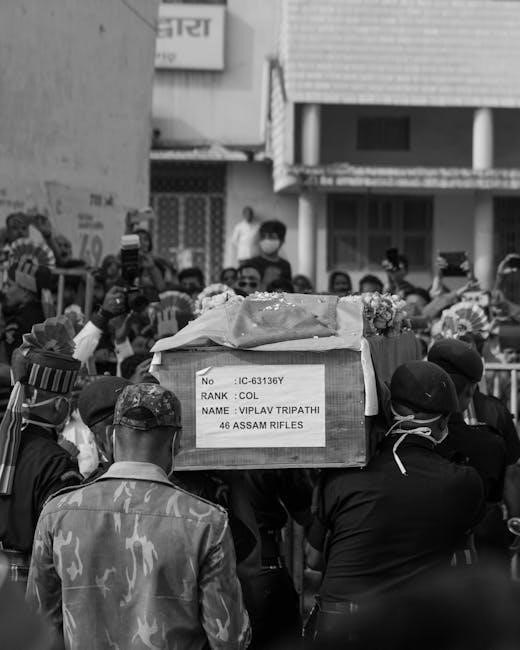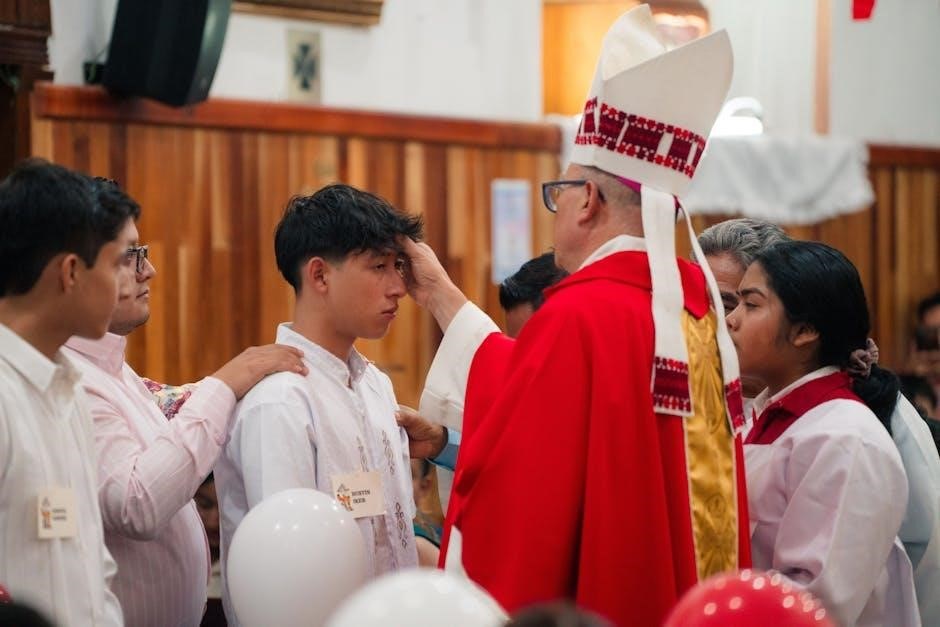The Catholic Church’s funeral rites are a sacred tradition honoring the deceased, offering comfort to mourners, and celebrating the Paschal mystery of Christ’s resurrection. These rites, outlined in the Order of Christian Funerals, include the Vigil, Funeral Mass, and Rite of Committal, providing a structure to prayerfully accompany the deceased to eternal life while supporting the grieving community.
Overview of Catholic Funeral Traditions
Catholic funeral traditions are rooted in the Church’s belief in the resurrection and eternal life, offering a structured and meaningful way to honor the deceased. The Order of Christian Funerals guides these rites, which include the Vigil, Funeral Mass, and Rite of Committal. These traditions emphasize prayer, scripture, and sacramental symbols, such as the pall, holy water, and incense, to express faith and hope. The Funeral Mass, centered on the Eucharist, is the central act of worship, celebrating Christ’s victory over death. The community plays a vital role, providing support to the grieving family through participation in prayers and rituals. These traditions aim to console the mourners while affirming the dignity of the deceased and their union with Christ.
The Purpose of Funeral Rites in the Catholic Church
The purpose of Catholic funeral rites is to honor the deceased, provide consolation to the grieving, and offer worship to God. These rites affirm the Church’s belief in the resurrection and eternal life, rooted in the Paschal mystery of Christ. Funeral liturgies, as outlined in the Order of Christian Funerals, serve as a celebration of the deceased’s life, commending them to God’s mercy and offering hope to those who mourn. The rites also strengthen the faith of the community, reminding all of God’s love and the promise of eternal life. They provide a sacred space for prayer, reflection, and support, ensuring the deceased is accompanied with dignity and love on their final journey.
The Structure of the Funeral Rites
The Catholic funeral rites are structured into three main parts: the Vigil Service, the Funeral Mass, and the Rite of Committal. Each component serves a distinct purpose, ensuring a prayerful and dignified farewell to the deceased. The Vigil Service, typically held before the Funeral Mass, provides an opportunity for family and friends to gather, pray, and share memories. The Funeral Mass, the central ceremony, includes the Liturgy of the Word and the Eucharistic Sacrifice, emphasizing the resurrection and eternal life. Finally, the Rite of Committal takes place at the burial site, where prayers are offered for the deceased’s soul. This structured approach guides the faithful through grief, offering hope and consolation while honoring the deceased’s life and faith. The Order of Christian Funerals outlines these rites, ensuring a meaningful and sacred experience.

The Vigil Service
The Vigil Service, held before the Funeral Mass, gathers family and friends to pray, share memories, and seek God’s mercy for the deceased, offering comfort and hope.
The Purpose of the Vigil Service
The Vigil Service, often held the evening before the Funeral Mass, serves as a time to pray for the deceased, seek God’s mercy, and comfort the grieving. It provides an opportunity for family and friends to gather, share memories, and reflect on the life of the departed. The vigil is a sacred moment to transition from mourning to hope, emphasizing the resurrection and eternal life through Christ. Prayers, readings, and personal reflections during the vigil help the community process their loss and find solace in faith. This rite also prepares the assembly for the Funeral Mass, fostering a spirit of unity and prayerful remembrance. The vigil is a cornerstone of Catholic funeral traditions, blending sorrow with the promise of eternal life.
Structure of the Vigil Service
The Vigil Service typically begins with an entrance song and a greeting by the presiding minister, followed by the sprinkling of holy water and the placement of a pall on the casket. The service includes prayers, readings from Scripture, and a homily or reflection. Family and friends may share personal remembrances of the deceased, offering a human touch to the liturgy. The vigil may also include the recitation of the Rosary or other devotional prayers. The service concludes with intercessory prayers for the deceased and the bereaved, followed by a final blessing. This structured yet flexible format allows for both communal worship and personal expression, creating a meaningful experience for all who participate.
Prayers and Readings During the Vigil
The Vigil Service incorporates specific prayers and readings to honor the deceased and console the bereaved. The service often includes the Magnificat and the Canticle of Simeon, which reflect themes of hope and trust in God. Scriptural readings are typically chosen from the Old and New Testaments, such as passages from the Book of Job or the Book of Revelation, emphasizing resurrection and eternal life; A homily or reflection by the presider provides spiritual guidance and personalizes the service. The Our Father is also recited, uniting the assembly in prayer for the deceased and the living.
Optional elements include the recitation of the Rosary or the Litany for the Deceased, which invoke the intercession of the saints. These prayers and readings serve to express faith, offer comfort, and reaffirm the hope of resurrection.
The Role of Family and Friends in the Vigil
Family and friends play a vital role in the Vigil Service, offering emotional and spiritual support to one another. They may participate by placing the pall on the casket, symbolizing baptismal garments, and by sharing personal memories or remembrances of the deceased. This personalization helps honor the individual and provides comfort to the grieving.
Family members or friends may also lead prayers, such as the Rosary or specific vigils, fostering a sense of community and shared faith. Their involvement not only strengthens their bond but also allows them to actively process their grief. This collective participation reflects the Catholic emphasis on communal support during times of loss.

The Funeral Mass
The Funeral Mass is the central sacramental celebration of Catholic funeral rites, honoring the deceased and offering hope through the Eucharistic sacrifice, comforting the mourners.
The Significance of the Funeral Mass
The Funeral Mass holds profound significance as it solemnly commemorates the deceased and affirms the Christian belief in eternal life through Christ’s resurrection. This sacred rite provides comfort to the grieving by uniting them with the community in prayer and the Eucharistic celebration. The Mass serves as a powerful expression of faith, hope, and love, offering solace and strength to those mourning. It also reflects the Church’s teachings on the dignity of human life and the promise of eternal rest with God, making it a cornerstone of Catholic funeral traditions.
The Introductory Rites
The Introductory Rites of the Funeral Mass begin with the priest and ministers entering the church, followed by the casket. The rite includes a greeting, prayers, and the sprinkling of holy water, symbolizing purification and remembrance of baptism. A pall, often placed on the casket, signifies the deceased’s equality in death and unity with the community. These rites create a solemn yet hopeful atmosphere, preparing the assembly to celebrate the Mass and commend the deceased to God. They also provide comfort to the family and mourners through prayer and ritual, emphasizing the Church’s support during this time of loss.
The Liturgy of the Word
The Liturgy of the Word is a central part of the Funeral Mass, consisting of readings from Scripture that bring comfort and hope to the mourners. Typically, there are three readings: one from the Old Testament, a Responsorial Psalm, and a New Testament reading, followed by the Gospel. These readings are chosen for their themes of God’s mercy, the resurrection of the dead, and eternal life. The homily, based on the readings, reflects on the deceased’s life and the promise of eternal life through Christ. This liturgical section reminds the faithful of God’s love and the hope of being reunited with the deceased in heaven, offering spiritual nourishment during a time of grief.
The Eucharistic Sacrifice
The Eucharistic Sacrifice is the heart of the Funeral Mass, where the Church offers the Holy Eucharist for the deceased and the living. This sacred rite is rooted in Catholic belief in the real presence of Christ in the Eucharist. Through the consecration of bread and wine, the sacrifice of Christ is re-presented, uniting the deceased with the Paschal mystery. The Eucharistic Prayer includes intercessions for the deceased, asking God to welcome them into eternal life. The congregation participates through prayer and, if appropriate, the reception of Communion. This sacramental act provides comfort to the mourners, strengthening their faith and hope in the resurrection. The Eucharistic Sacrifice is a profound expression of the Church’s belief in the transformative power of Christ’s death and resurrection.
The Final Commendation
The Final Commendation marks the conclusion of the Funeral Mass, where the Church entrusts the deceased to God’s loving mercy. This rite includes prayers of commendation, asking for forgiveness and peace for the deceased. The priest sprinkles the coffin with holy water and incenses it, symbolizing purification and respect for the body as a temple of the Holy Spirit. These acts affirm the dignity of the deceased and the hope of resurrection. The community joins in prayer, seeking God’s consolation and strength for those grieving. The Final Commendation serves as a powerful reminder of the Church’s belief in eternal life and its trust in God’s infinite love.

The Rite of Committal
The Rite of Committal is the final step in Catholic funeral rites, where the deceased is laid to rest. It includes a procession to the cemetery, prayers at the graveside, and symbolic gestures like the sprinkling of holy water and incense. This rite emphasizes hope in the resurrection and provides comfort to mourners, reaffirming the Church’s belief in eternal life and God’s loving care for the departed.
The Procession to the Cemetery
The procession to the cemetery is a solemn and dignified part of the Rite of Committal, marking the final journey of the deceased to their resting place. Typically led by a priest or deacon, the procession includes pallbearers carrying the casket, followed by the family and mourners. This act symbolizes the community’s respect and farewell to the deceased. The procession may also include the recitation of prayers or the singing of hymns, further emphasizing the spiritual nature of the rite. Upon arrival at the cemetery, the group gathers at the gravesite for the final prayers, which culminate in the committal of the body to the earth. This procession serves as a poignant reminder of the deceased’s transition to eternal life, surrounded by the support and faith of the community.
Prayers at the Graveside
At the graveside, specific prayers are recited to seek God’s mercy and comfort for the deceased and their loved ones. The priest typically leads the congregation in prayers, which may include the recitation of the Our Father, hymns, or scriptural readings. The Prayer of Committal is central, asking God to receive the deceased into eternal rest. Holy water may be sprinkled on the casket as a symbol of purification and baptismal renewal. Incense can also be used to signify prayer rising to heaven and the dignity of the human body. These graveside prayers emphasize hope in the resurrection and trust in God’s loving judgment. They provide solace to the grieving while affirming the belief in eternal life.
The Significance of Burial in Catholic Tradition
Burial holds profound significance in Catholic tradition, reflecting the Church’s reverence for the human body as a temple of the Holy Spirit. It underscores the belief in the resurrection of the body and the dignity of human life created in God’s image. The Catholic Church prefers burial over cremation, as it aligns with the biblical tradition of respecting the body and awaiting the final resurrection. The act of burial serves as a witness to the community’s faith in eternal life and their hope in Christ’s promise to raise the dead. This sacred practice comforts the grieving by emphasizing that death is not an end but a transition to eternal life with God.

Planning and Preparing for a Catholic Funeral
Planning a Catholic funeral involves guidance from the parish, selecting appropriate readings, music, and ensuring the rites are conducted with dignity and respect for tradition.
Choosing Appropriate Readings and Music
Selecting suitable readings and music for a Catholic funeral is a meaningful way to honor the deceased and reflect their faith journey. The Order of Christian Funerals provides specific guidelines for readings, typically drawn from Scripture, to emphasize hope, resurrection, and comfort. Families are encouraged to choose passages that resonate with the deceased’s life and faith. Music must be sacred and liturgical, avoiding secular songs, to maintain the dignity of the service. Hymns and chants that reflect the Paschal mystery are recommended. The parish often assists in selecting appropriate music and readings, ensuring they align with Catholic tradition and the liturgical norms. This thoughtful preparation helps create a prayerful and consoling atmosphere for all participants. Proper selections enhance the spiritual significance of the funeral rites.
The Role of the Funeral Director
The funeral director plays a vital role in coordinating the logistical aspects of a Catholic funeral, ensuring the rites are conducted with dignity and respect. They work closely with the family to understand their needs and preferences, assisting with arrangements such as transportation, preparation of the body, and coordination with the parish. Funeral directors also help facilitate the placement of the pall, holy water, and other symbolic elements during the service. Additionally, they ensure compliance with Catholic traditions and liturgical guidelines, collaborating with the parish staff to maintain the integrity of the funeral rites. Their support allows the family to focus on their grief and participation in the liturgy, creating a meaningful and prayerful experience for all involved.
Involving the Family in the Planning Process
Family involvement is integral to planning a Catholic funeral, ensuring the rites reflect the deceased’s life and faith. Loved ones are encouraged to participate in selecting readings, music, and prayers, personalizing the service while adhering to Catholic traditions. Families may also choose pallbearers, prepare eulogies, or contribute personal reflections during the Vigil. This involvement not only honors the deceased but also provides a meaningful way for the family to process their grief. Collaboration with the funeral director and parish ensures that the chosen elements align with liturgical guidelines, creating a dignified and faith-filled celebration of life. Through active participation, the family finds comfort in fulfilling their loved one’s final wishes and upholding their Catholic heritage.
Symbolism in Catholic Funeral Rites
Catholic funeral rites are rich in symbolism, with elements like the pall, holy water, and incense signifying purification, mercy, and the deceased’s transition to eternal life.
The Use of the Pall
The pall, a white cloth placed over the casket or coffin, is a meaningful symbol in Catholic funeral rites. It represents the baptismal garment, signifying the deceased’s identity as a child of God and their renewal in Christ. The pall is often draped over the casket by family members or friends, with the assistance of the funeral director, during the introductory rites of the Funeral Mass. This act emphasizes unity and equality before God, regardless of the deceased’s earthly status. The white color symbolizes purity, hope, and the resurrection. The pall serves as a visual reminder of the deceased’s baptismal promises and their journey toward eternal life, comforting mourners with its profound spiritual significance.
The Symbolism of Holy Water and Incense
Holy water and incense hold profound symbolic meanings in Catholic funeral rites. Holy water, blessed by the Church, is used to sprinkle the casket or grave, invoking purification and protection for the deceased. It reminds mourners of the soul’s journey to God and the hope of eternal life. Incense, with its fragrant smoke, symbolizes the prayers of the faithful rising to heaven, creating a sacred atmosphere and honoring the deceased. Together, these elements express the Church’s belief in the purification of the soul and the power of communal prayer. They bring comfort to the grieving by connecting earthly rituals to heavenly intercession, emphasizing hope and resurrection.
The Funeral Mass is the principal celebration of the Catholic funeral rites, offering worship, praise, and thanksgiving to God for the gift of life. It is a memorial of Christ’s death and resurrection, emphasizing the hope of eternal life. Through the Eucharist, the Church believes the deceased is united with Christ in His Paschal mystery, while the living find strength in the proclamation of God’s mercy and love. The Mass is not only a farewell to the deceased but also a source of consolation and hope for the grieving family and friends. It reaffirms the Catholic belief in the resurrection and the eternal life promised through Christ, making it a cornerstone of Catholic funeral traditions.
The Role of the Funeral Liturgy Outside of Mass
The Funeral Liturgy Outside of Mass is a meaningful alternative when the Eucharistic Sacrifice is not possible. It maintains the essential elements of prayer, Scripture readings, and intercessions, providing comfort and hope to the mourning community. Led by a priest, deacon, or lay minister, this liturgy includes the reception of the body, opening prayer, readings, homily, and final commendation. It serves as a dignified way to honor the deceased and support the grieving family, emphasizing God’s mercy and the hope of resurrection. This rite ensures that even without Mass, the Church’s tradition of prayerful farewell is upheld, offering solace and spiritual strength to those who mourn.

The Role of the Community in Funeral Rites
The community plays a vital role in Catholic funeral rites by participating in prayer, offering support to the grieving family, and collectively expressing faith in eternal life.
The Importance of Community Participation
Community participation is essential in Catholic funeral rites, as it provides spiritual support to the grieving family and strengthens communal bonds. Through shared prayer and rituals, the community expresses faith in eternal life and offers consolation. The collective presence of parishioners during the Vigil, Funeral Mass, and Rite of Committal symbolizes unity and solidarity. This shared experience not only honors the deceased but also reaffirms the Church’s teachings on resurrection and eternal life. Active involvement fosters a sense of belonging and mutual care, reflecting the Church’s commitment to accompanying the faithful in life’s final journey. Such participation is a testament to the enduring legacy of Catholic funeral traditions.
The Role of the Parish in Providing Support
The parish plays a vital role in providing spiritual and emotional support during Catholic funeral rites. Parish staff and bereavement teams are trained to minister to those who mourn, offering guidance and consolation. They assist families in planning the funeral liturgy, ensuring it reflects the deceased’s life and faith. The parish also provides resources such as prayer services, bereavement groups, and educational materials to help families navigate their grief. By fostering a sense of community, the parish ensures no one grieves alone, embodying Christ’s compassion and the Church’s commitment to care for the faithful in life and death. This support extends beyond the funeral, helping families heal and find hope in their faith.
Catholic funeral rites provide a profound expression of faith, hope, and consolation, celebrating the deceased’s life while offering support to the grieving. These sacred traditions embody the Church’s enduring legacy, ensuring the faithful are accompanied with dignity and prayer on their final journey, reflecting God’s mercy and the promise of eternal life.
The Enduring Legacy of Catholic Funeral Rites
The Catholic funeral rites stand as a testament to the Church’s enduring tradition of honoring the deceased while comforting the living. Rooted in scripture and centuries of devotion, these rituals provide a meaningful framework to celebrate life, mourn loss, and express hope in the resurrection. The use of symbols, such as the pall, holy water, and incense, reinforces the sacred nature of the rites. By participating in the Vigil, Funeral Mass, and Rite of Committal, the faithful find solace in communal prayer and the promise of eternal life. These rites not only pay tribute to the departed but also strengthen the bonds of faith within the community, ensuring the legacy of Catholic funeral traditions endures for generations.

Final Thoughts on the Significance of Funeral Rites
Catholic funeral rites hold profound significance as they provide a sacred space for mourning, hope, and spiritual renewal. These rituals, deeply rooted in faith, offer comfort to the bereaved by celebrating the life of the deceased and affirming the promise of eternal life through Christ’s resurrection. The rites foster a sense of community, uniting family and friends in prayer and solidarity. By honoring the deceased with dignity and prayer, the Church reaffirms its belief in the Paschal mystery, where death is not an end but a transition to eternal life; Funeral rites thus become a powerful expression of faith, love, and hope, guiding mourners through their grief while strengthening their connection to God and one another.

